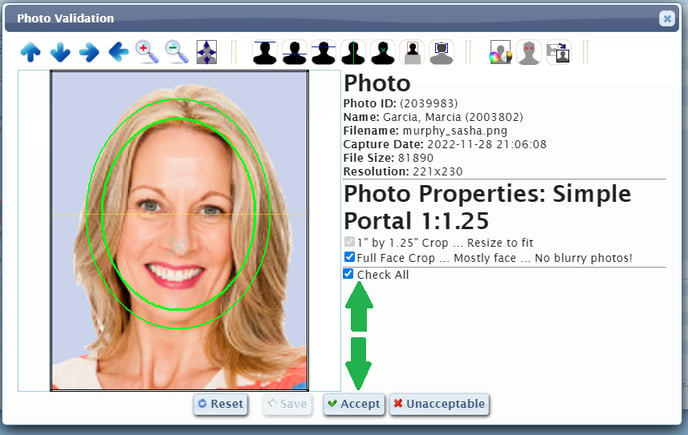What are the basics of photos and standards?
Photos are a critical element of the Veonics® Portal and are considered “independent” entities. They exist independently from data and are “traceable” through each photo status.
Security
- From the moment photos are brought into the Veonics® Portal, they are “marked” with a secured cryptographic signature to ensure authenticity.
Photo Status in Record Manager
- To be considered suitable for printing in the Record Manager, the photo in the card record must be validated against appropriate photo Standards with an Accepted status.
- Status Types
- Missing Photo
- No photo is attached to the Record
- Accepted
- The photo has been checked against the standard and found to be in compliance
- All the rules in the standard must be met
- Missing Photo
-
- Pending Validation
- There is a photo, but it has not yet been validated against the standard
- Unacceptable
- The photo has been checked against the standard and can not be made compliant
- At least one of the rules was not met
- And it is not possible to manipulate the image to make it acceptable
- A new photo must be provided to replace this
- Pending Validation
Photo Standards
- Photo standards are simply a collection of rules that the photo must comply with to be considered suitable

- Some rules may be automatically or semi-automatically enforced
- Aspect Ratio: this is a mandatory rule
- Coverage: determines the expected size and position of the face in the image
- This is a “complex” rule, explained below
- Minimum/maximum resolution
- A low-resolution results in a “grainy” printout
- A high resolution wastes storage space and makes processing slower
- Other rules are “informational” and must be manually verified by a qualified user
- Organizations may have their own “private” standards
- Light-colored solid background
- 75% Full face with no cut-off facial features
- No hats, visors, or scarves
- , “background of a specific color”
- New standards may be “cloned” and modified from existing ones
Photo Coverage
- The coverage rule determines the position and relative size of the face in the photo
- Depends on the aspect ratio (Height by Width), which is hard set within the Standard
- This rule governs the green circular overlay in the photo validation tool and the automatic cropping tool
Photo Coverage Attributes
- A coverage rule is composed of the following attributes
- % horizontal coverage: what percentage of the entire image width must be covered by the face itself (ear to ear)
- % vertical coverage: what percentage of the entire image height must be covered by the face itself (chin to top of head)
- % horizontal center (default, 50%): position of the horizontal center of the face, relative to the entire image
- % vertical center (default, 50%): position of the vertical center of the face, relative to the entire image
- Typically, in portrait-oriented photos, this will be less than 50%, to allow for the neck and upper part of the body to show
- % tolerance: this determines the space between the concentric ovals in the validation tool, and how much the photo may be “nudged” in order to bring it to compliance when processing automatically
- % eyeline (default, 50%, and generally should match the % vertical center): determines the vertical position of the eyes in the photo
- % H/V center mark: this is the blue cross on the overlay, useful to do a one-click center around a particular facial feature (typically, the tip of the nose)
